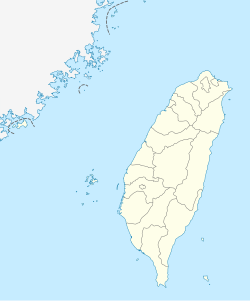Makung
|
Magong 馬公市 |
||
|---|---|---|
| County-controlled city | ||

View of Siying Rainbow Bridge and Penghu area in Magong
|
||
|
||
| Location in the Republic of China | ||
| Coordinates: 23°34′N 119°35′E / 23.567°N 119.583°ECoordinates: 23°34′N 119°35′E / 23.567°N 119.583°E | ||
| Country | Republic of China (Taiwan) | |
| Province | Taiwan Province (streamlined) | |
| County | Penghu County | |
| Area | ||
| • Total | 33.9918 km2 (13.1243 sq mi) | |
| Population (December 2014) | ||
| • Total | 60,335 | |
| • Density | 1,800/km2 (4,600/sq mi) | |
| Website | www.mkcity.gov.tw | |
| Magong | |||||||||||||||
| Chinese name | |||||||||||||||
|---|---|---|---|---|---|---|---|---|---|---|---|---|---|---|---|
| Traditional Chinese | |||||||||||||||
| Simplified Chinese | |||||||||||||||
| Literal meaning | Horse Lord | ||||||||||||||
|
|||||||||||||||
| Port Magong | |||||||||||||||
| Traditional Chinese | |||||||||||||||
| Simplified Chinese | |||||||||||||||
| Literal meaning | Port of the Mother's Palace | ||||||||||||||
|
|||||||||||||||
| Japanese name | |||||||||||||||
| Kanji | |||||||||||||||
|
|||||||||||||||
| Transcriptions | |
|---|---|
| Standard Mandarin | |
| Hanyu Pinyin | Mǎgōng |
| Wade–Giles | Ma³-kung¹ |
| Tongyong Pinyin | Mǎgong |
| Southern Min | |
| Hokkien POJ | Má-keng |
| Transcriptions | |
|---|---|
| Standard Mandarin | |
| Hanyu Pinyin | Māgōng'ào |
| Wade–Giles | Ma-kung-ao |
| Transcriptions | |
|---|---|
| Romanization | Makō |
Magong, formerly romanized as Makung, is a "county-controlled" city on the western part of Penghu Island in the Pescadores (Penghu Islands) in the Taiwan Strait. It is the seat of Penghu County, administered by the Republic of China on Taiwan.
The settlement's temple honoring the Chinese sea goddess Mazu, the deified form of the medieval Fujianese shamaness Lin Moniang, is usually accounted the oldest in all of Taiwan and Penghu. The town was originally named Makeng (Chinese: ; Pe̍h-ōe-jī: Má-keng; literally: "mother's palace") but was changed to Makō (馬公?) during Japanese rule in 1920, and was the center of the Mako Guard District.
After 1945, the Wade-Giles romanization Makung was used. Taiwan officially adopted Hanyu Pinyin in 2009, leading to the romanization Magong.
...
Wikipedia


